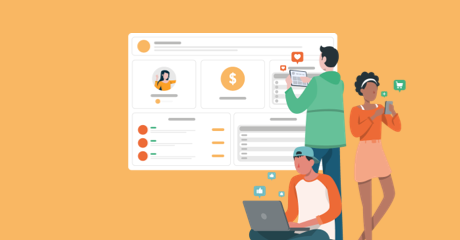What is brand loyalty and why is it important in a cookieless world?
“82% of Gen K, 85% of Millenials, 84% of Gen X and 80% of baby boomers say the loyalty program has enhanced their experience of the brand.”
These numbers, from Rare Consulting’s Loyalty report, are striking as they show similar consumer behaviour across generations, a rare feat in the world of consumer marketing! So what is brand loyalty and why is it going to be increasingly important in the current business ecosphere and in the cookieless world?
What is brand loyalty?
There is an initial distinction to be made between ‘customer loyalty’ and ‘brand loyalty’:
- Customer loyalty relates to the spending power of consumers, and is defined by Oracle as “an ongoing emotional relationship between you and your customer, manifesting itself by how willing a customer is to engage with and repeatedly purchase from you versus your competitors.”
- Brand loyalty on the other hand is defined by Retention Science as having “very little to do with price or money […], everything to do with how consumers perceive your brand.”
In both cases, loyalty is understood as “a byproduct of a customer’s positive experience with you and works to create trust”, and a customer will be more loyal to a brand if they believe they’ll receive better service and higher quality products from them than from other brands.
Customer loyalty can be upheld by keeping prices low and offering regular discounts, promotions and special offers, thus convincing customers that your brand’s products are the best value on the market and encouraging them to not buy from others. Brand loyalty is easier to maintain once it is established, as it rests mainly on the consumer’s experience with a brand – so as long as your products and the level of service you provide are high quality, your customers are less likely to be checking out the competition.
So both customer loyalty and brand loyalty go hand in hand and are as important as each other.
Why the need for loyalty?
Recent studies have shown that a brand is 60 to 70% more likely to sell to an existing customer than to a new one; that 73% of consumers will recommend brands with good loyalty programs; and that 87% of consumers want to have loyalty programs. These numbers clearly show that loyalty programs are highly relevant for any brand wanting to engage with their audience and build more meaningful relationships with them.
Customer data is one of the most powerful tools a brand has at their disposal, especially in this day and age of Big Data and omniscient information technology. We recently took a closer look at how tricky it can be to collect qualitative data in the Retail sector, and these challenges are being faced across all sectors. Meaning that one of the greatest challenges that brands are facing today is how to utilise this customer data, that they mostly already possess, in a way that harnesses its full potential.
Another key issue at stake for consumer brands and media companies is customer retention, so how to keep customers returning and purchasing again. Loyal customers will generally think highly of a brand and of their products and services, thus increasing the likelihood of them repeatedly buying from that brand. So building and enriching the relationship that consumers have with a brand by understanding what their expectations are is key.
Recent events, like the COVID-19 pandemic and the implementation of new data policies, like GDPR, have meant that the need for companies to embark and advance on their digitalisation journey is now greater than ever before. These same trends, with others like the end of third-party cookies and the ease of implementing an SSO, have also had an influence on how digitally prepared companies are to take the next steps. Systems that would have been unthinkable 5 years ago are now easily set up and a vast majority of brands are looking for the next steps on their digital journey, and for many loyalty programs are the answer.
One trend that has come out of the recent pandemic is that brands have had to engage more with their audience online, and have therefore re-prioritised their messaging – so rather than focusing on promotional and discount messaging as they would have done before, they’re instead working on building an emotional relationship with their audience. A lot of brands jumped on board with this trend and got creative during the early stages of the pandemic. And most of them have carried on using these types of campaigns as customers responded so well to them! Perfect examples include personalised gift guides, user-generated content votes and contests, recipe sharing and personality tests. Not only do consumers respond to a more engaged approach to marketing, they are also much more interested in loyalty programs. Figures show an increase of between 46 and 55% in the number of points redeemed compared to before the pandemic.
“Votre musique au stade” from LOSC, “Saint James cocktail photo upload contest” by Bruggeman, and “La dépanneuse d’inspiration” from Le Drugstore Parisien
Beyond this new wave of engagement and the advantages of collecting customer data, these actions also serve another wider purpose: they help to create a community. And when building brand loyalty, community is key. If a customer feels a sense of belonging and connection with a brand, they are much more likely to return to this brand and spend more.
Where do cookies come into the equation?
Google announced at the beginning of 2020 that they’d no longer be supporting third-party cookies on their browsers from the end of 2023. This announcement understandably sent shockwaves through the digital landscape as most brands had until then relied on third-party cookies to segment their audience and provide their customers with personalised brand experiences. The demise of cookies will mean that brands are having to come up with new ways of sourcing this data, and that first- and zero-party data will be key for any brand wanting to provide their audience with an enriching and personalised experience.
By including a loyalty program into their first- and zero-party data collection strategy, brands will be able to reward their audience for all the touch points they have with a brand. Whether it’s making a purchase, reading content on their website, interacting with their social media pages, or watching one of their videos, brands will be able to give their audience points, badges, special offers, etc and in exchange they’ll be harvesting precious information directly from their audience, allowing them to create highly personalised marketing actions and brand experiences, in a totally secure and compliant manner.
With the disappearance of third-party cookies, and the dependence that many brands had on them, collecting first- and zero-party data will become the new normal and is increasingly being leveraged through interactive marketing and engagement. The advantage of these data collection strategies is that the consumer is sharing their information willingly with a brand, meaning that they explicitly trust them with it. When a customer signs up for a loyalty program by providing their information, they’re saying that they trust a brand and that they want to hear from them and interact with them.
Loyalty programs as the solution
Does the age-old concept of loyalty still stand? Yes and no, the key difference is that consumer’s expectations have drastically changed recently. Consumers now expect that in exchange for their data, they will receive an improved and personalised brand experience. They are expecting much more than simply a transactional relationship: they want a connection and an emotional relationship with a brand. At Qualifio we believe that the definition of loyalty needs to be updated so that all interactions with a brand are included, and not just purchases.
So brands need to get creative and think outside of the box when it comes to setting up their loyalty programs, they need to be rewarding all the different types of interactions that a consumer is having with them, not just their purchases. In this way, it becomes possible to engage with and collect first- and zero-party data from a consumer even before they’ve considered making a purchase with a brand. Maybe they’ve followed a brand’s social media pages or downloaded a product description, whatever their first interaction with a brand has been, the brand can already start rewarding them for this, even before a purchase is on the cards.
Emails sent through a loyalty program are showing much higher open rates than more traditional promotional emails. This means that customers are clearly pointing to the fact that they no longer want to receive generic emails, they want personalised messages instead. The emails from a loyalty program will contain information about their progress, the number of points they’ve earned and the rewards they can claim, so they’re much more likely to open them and interact with them.
Qualifio Loyalty
Find out more about Qualifio Loyalty or watch our launch webinar and learn how the platform allows you to set up creative and innovative loyalty programs that are based on interactivity and engagement, rather than only on purchases, allowing you to reward your audience for all the interactions they have with your brand.
Qualifio Loyalty gives full autonomy back to marketeers and allows them to start small with their loyalty plans, getting their program(s) online quickly. They’ll be able to plug their Qualifio Engage campaigns into their program with no complicated development needed, and then build up their programs from there. The flexibility of the platform allows them to add components, rules and modules as their audience grows and evolves. And as with Qualifio Engage, Qualifio Loyalty integrates with any marketing tools that our customers are currently working with.
All Qualifio Loyalty programs are based around 4 key elements:










